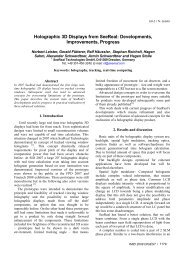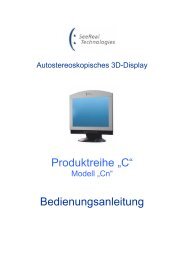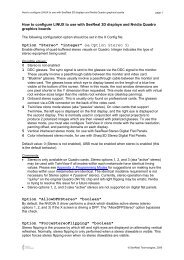Capabilities of diffractive optical elements for real ... - ResearchGate
Capabilities of diffractive optical elements for real ... - ResearchGate
Capabilities of diffractive optical elements for real ... - ResearchGate
Create successful ePaper yourself
Turn your PDF publications into a flip-book with our unique Google optimized e-Paper software.
Copyright 2008 Society <strong>of</strong> Photo-Optical Instrumentation EngineersThis paper was (will be) published in Conference Proceedings Volume 6912 Practical Holography XXII:Materials and Applications and is made available as an electronic reprint with permission <strong>of</strong> SPIE. Oneprint or electronic copy may be made <strong>for</strong> personal use only. Systematic or multiple reproduction,distribution to multiple locations via electronic or other means, duplication <strong>of</strong> any material in this paper<strong>for</strong> a fee or <strong>for</strong> commercial purposes, or modification <strong>of</strong> the content <strong>of</strong> the paper are prohibited.
<strong>Capabilities</strong> <strong>of</strong> <strong>diffractive</strong> <strong>optical</strong> <strong>elements</strong> <strong>for</strong><strong>real</strong>-time holographic displaysStephan Reichelt, Hagen Sahm, Norbert Leister and Armin SchwerdtnerSeeReal Technologies GmbH, Blasewitzer Str. 43, 01307 Dresden, GermanyABSTRACTThis paper illustrates one <strong>of</strong> the various capabilities <strong>of</strong> static <strong>diffractive</strong> <strong>optical</strong> <strong>elements</strong> (DOE) beneficial to <strong>real</strong>timeholographic displays. Custom kin<strong>of</strong>orm-type DOE can be used as <strong>elements</strong> <strong>for</strong> illumination <strong>of</strong> the spatiallight modulator, i.e. the display where the video hologram is encoded. For an RGB application <strong>of</strong> <strong>diffractive</strong><strong>optical</strong> <strong>elements</strong>, particular issues concerning the inherent wavelength-dependence have to be addressed. MultiorderDOE <strong>of</strong>fer a way to compensate <strong>for</strong> chromatic as well as monochromatic aberrations. We will discussconcepts and per<strong>for</strong>mance <strong>of</strong> multi-order DOE, show their application in holographic displays, describe issues <strong>of</strong>fabrication and replication, and give experimental results <strong>of</strong> the multi-order DOE per<strong>for</strong>mance.Keywords: Electro-holography, 3D Display, Multi-order <strong>diffractive</strong> <strong>optical</strong> <strong>elements</strong>1. INTRODUCTIONReal-time holography is the ne plus ultra art and science <strong>of</strong> visualizing fast temporally changing three-dimensionalscenes. The integration <strong>of</strong> the <strong>real</strong>-time or electro-holographic principle into display technology is one <strong>of</strong> the mostpromising and challenging developments <strong>for</strong> the future consumer display and TV market. Only holography allowsthe reconstruction <strong>of</strong> natural-looking 3D scenes, and there<strong>for</strong>e provides observers with a completely com<strong>for</strong>tableviewing experience. Recently, we have developed a novel approach to <strong>real</strong>-time display holography overcomingthe challenges <strong>of</strong> classic holography by combining an overlapping sub-hologram technique with a tracked viewingwindowtechnology. 1, 2 For the first time this enables solutions <strong>for</strong> large screen interactive holographic displays.Diffractive <strong>optical</strong> <strong>elements</strong> (DOE) are versatile <strong>elements</strong> on their way to becoming state-<strong>of</strong>-the-art componentsin a variety <strong>of</strong> <strong>optical</strong> systems. DOE <strong>of</strong>fer a flat, space-saving integration, high-accuracy, nearly arbitrarywavefront shaping, and high diffraction efficiency. However, when blazed <strong>for</strong> an operation at first order, a DOEexhibits a significant dispersion due to the wavelength-dependent diffraction. To overcome this limitation, socalledmulti-order or harmonic <strong>diffractive</strong> lenses were introduced independently by Sweeney and Sommargren 3and Morris and Faklis 4 in 1995. They showed that a <strong>diffractive</strong> lens with multi-wavelength path-length stepsrather than a single-wavelength step has the same <strong>optical</strong> power <strong>for</strong> a set <strong>of</strong> discrete wavelength whereby broadbandor multi-spectral applications become feasible. It has also been shown that such higher-blazed <strong>diffractive</strong><strong>elements</strong> have both <strong>diffractive</strong> and refractive properties. 5–7An important design aspect <strong>of</strong> a 3D holographic display is the flatness <strong>of</strong> the screen which should be in thesame dimension as today’s standard LCD. But the requirements <strong>for</strong> a backlight used in holographic displayscompletely differ from that <strong>for</strong> standard displays. In holography a well-defined, coherent wavefront is neededto reconstruct the 3D scene. When using standard refractive optics <strong>for</strong> reference wave collimation, the pricewe have to pay is a relatively large depth <strong>of</strong> the backlight to avoid aberrations. Here, multi-order DOE can beadvantageously used to provide a well-defined reference wave <strong>for</strong> the hologram reconstruction at the given RGBwavelengths.E-mail: sre@see<strong>real</strong>.com, Phone: +49 (0)351 450 3240, Web: http://www.see<strong>real</strong>.comProceedings <strong>of</strong> SPIE, Vol. 6912, Practical Holography XXII: Materials and Applications, Editor(s): Hans I. Bjelkhagen;Raymond K. Kostuk, p. 69120P, (2008). http://dx.doi.org/10.1117/12.76288769120
2. SEEREAL’S REAL-TIME HOLOGRAPHIC DISPLAY SOLUTIONFor the sake <strong>of</strong> a better understanding we briefly recapitulate the basic principles <strong>of</strong> our novel approach to<strong>real</strong>-time display holography in a phenomenological way. For a more comprehensive description we refer to thereferences. 8, 9The fundamental idea in our concept <strong>of</strong> an electro-holographic display is to give highest priority to reconstructthe wave field at the observer’s eyes and not the three-dimensional object itself. Figure 1 illustrates the principle.Reconstruction <strong>of</strong> a single scene point<strong>for</strong> fixed observer positionTracked viewing windowWastedin<strong>for</strong>mationSub-HologramEssentialin<strong>for</strong>mationReconstructedscene pointHologramVirtualviewing windowFigure 1. Schematic drawing <strong>of</strong> SeeReal’s approach to <strong>real</strong>-time holography, the so-called tracked viewing technology.In classic holography, the 3D scene in<strong>for</strong>mation is encoded in the entire hologram, i.e. every pixel <strong>of</strong> thehologram contributes to each object point. When illuminated by the reference wave, the combination <strong>of</strong> all<strong>of</strong> its cells reproduces the complete scene by means <strong>of</strong> multiple interferences. A classic hologram has a largeangular spectrum, which means that a large space-bandwidth-product is required. If a classic hologram is brokeninto a number <strong>of</strong> pieces, each piece will reconstruct the original scene, even though with less resolution and insmaller size. All past attempts <strong>of</strong> transferring classic holography to display and TV applications have faileddue to two inherent challenges: (1) display resolution and (2) data volume and processing. To give an example,extreme-resolution displays with a pixel size <strong>of</strong> roughly 0.5 microns would be required, which translates to thehuge demand <strong>for</strong> calculation <strong>of</strong> millions to billions <strong>of</strong> complex values <strong>for</strong> each <strong>of</strong> the 2 Mio scene points (1920 x1080) to determine an HDTV scene in 3D.When considering the human vision system regarding to where the image <strong>of</strong> a natural environment is receivedby a viewer, it becomes obvious that only the in<strong>for</strong>mation aimed at the pupils <strong>of</strong> the viewer is required to createthe complete scene. All other in<strong>for</strong>mation is wasted. This basic fact allows to <strong>real</strong>ize tracked <strong>real</strong>-time videoholography with the following key features.Viewing window. In our approach a wavefront originating from a 3D scene is reconstructed only in a smallregion called viewing window - its size being in the range <strong>of</strong> an eye pupil size. For an observer different viewingwindows <strong>for</strong> left and right eye are generated. Holography is based on diffraction. The pixel pitch <strong>of</strong> theholographic display determines the diffraction angle that can be used. For a viewing window type hologram onlya small diffraction angle from the display to the border <strong>of</strong> the viewing window is needed whereas in classicalholography the diffraction angle is related to the size <strong>of</strong> the 3D scene. So the constraint <strong>of</strong> small pixel pitch isdistinctly released in our approach. A display with a pitch in the range <strong>of</strong> 60 µm can be used.69121
Sub-hologram. A direct consequence <strong>of</strong> the viewing window setup is the following: For each reconstructedobject point there is only a limited region in the hologram where data from this object point is coded. Thislimited region is called sub-hologram. In contrast to a classical hologram, if a viewing window-type hologram isbroken into a number <strong>of</strong> pieces, each piece will reconstruct only part <strong>of</strong> the original scene, but with full resolution(apart from object points close to the border <strong>of</strong> the reconstructed scene fragment). The refractive analogue <strong>of</strong> asub-hologram is a small lens focusing light from the hologram to the object point.Real time calculation. Hologram calculation is done by setting the sub-hologram <strong>for</strong> each object point assimple lens function and then summing up different sub-holograms. In contrast to classical computer-generatedholograms no Fourier trans<strong>for</strong>m is required. Larger pixel pitch and sub-hologram approach reduce computationrequirements by a factor <strong>of</strong> 10,000 as compared to the classic approach. This allows <strong>for</strong> a <strong>real</strong> time calculation<strong>of</strong> holograms.Higher orders. Higher diffraction orders <strong>of</strong> each object point <strong>of</strong> the 3D scene are also generated. But lightfrom these points is located in higher diffraction orders outside the viewing window. They are not seen by theeye located inside its viewing window. So higher orders do not deteriorate the visible reconstruction <strong>of</strong> the scene.Tracking. In a classical film hologram with fine resolution and large diffraction angle an observer can movearound the hologram and see the reconstruction from different positions. In contrast to this the restriction <strong>of</strong>limiting the reconstruction to a viewing window would lead to a 3D scene only visible from a fixed observerposition unless an important additional feature is added to the setup, namely tracking. User tracking has beenknown be<strong>for</strong>e from autostereoscopic systems where some kind <strong>of</strong> sweet spots are moved in accordance with theobserver’s eye position. Such concepts have been adapted to holography, taking care <strong>of</strong> the fact, that coherence<strong>of</strong> the light his to be maintained during tracking. A camera system in combination with fast image processingalgorithms is used to detect the actual eye position <strong>of</strong> the observer. Then the viewing window is shifted in<strong>real</strong>-time to the new eye position, by <strong>optical</strong> or electronical means. Simultaneously hologram content is updatedby <strong>real</strong>-time calculation. Each object point shift <strong>of</strong> the viewing window also means a shift <strong>of</strong> its sub-hologramin opposite direction. This principle is illustrated in Figure 1 on the right side.3. BASICS OF MULTI-ORDER DOEDesign procedure. The design <strong>of</strong> a kin<strong>of</strong>orm-type 10 <strong>diffractive</strong> <strong>optical</strong> element starts with the calculation<strong>of</strong> its phase function. The continuous phase function φ <strong>of</strong> a thin <strong>diffractive</strong> phase element refers to the phasedifference between the desired output wave and the incident wave, i.e. that difference be<strong>for</strong>e and behind the<strong>diffractive</strong> elementφ(x, y) = φ out (x, y) − φ in (x, y), (1)where φ is related to the recording eikonal by φ(x, y) = k 0 G(x, y), with the free-space wave number k 0 = 2π/λ 0 .That is, φ is defined by the <strong>optical</strong> path difference introduced by the <strong>diffractive</strong> element and by its designwavelength λ 0 . The continuous phase function usually refers to the first diffraction order, which is designated asthe design order. In a second design step, the blazing procedure transfers the continuous phase function φ to amodulo m2π phase pr<strong>of</strong>ileΨ(x, y) = φ(x, y) mod (m2π), (2)where the integer-valued m is the so-called blaze order. The modulo operation – which represents the foundation<strong>of</strong> <strong>diffractive</strong> optics – is based on the fact, that a monochromatic wave is insensitive to phase jumps <strong>of</strong> multiples<strong>of</strong> 2π since the constructive interference condition is satisfied in any case. It is important to note that differentphase pr<strong>of</strong>iles Ψ can be created from the same underlying phase function φ, when higher orders than the usualfirst blaze order are chosen. Blazing the <strong>diffractive</strong> element <strong>for</strong> higher orders will alter the <strong>diffractive</strong> surfacepr<strong>of</strong>ile toward to more moderate feature sizes although with enlarged blaze depth. In general, the blaze orderm represents an additional design parameter <strong>of</strong> <strong>diffractive</strong> optics which has already been utilized in the past <strong>for</strong>adapting the minimum feature sizes to the manufacturing feasibility or <strong>for</strong> <strong>real</strong>izing multi-order harmonic DOE,69122
which are <strong>of</strong> special interest here. The latter type is associated with a harmonic multi-wavelength operation,i.e. the <strong>diffractive</strong> element is designed <strong>for</strong> and illuminated by a number <strong>of</strong> discrete wavelengths which fulfill thecondition <strong>of</strong>mλ 0 = qλ blaze . (3)700q = 3 q = 5 q = 7Blaze-matched wavelength λ blaze[nm]6506005505004504001000 2000 3000 4000 5000 6000 7000 8000Synthetic design wavelength λ syn[nm]Figure 2. Wavelength selection <strong>for</strong> multi-order DOE. For a given synthetic design wavelength λ syn exists N discrete wavelengthsλ blaze within the VIS spectral range <strong>for</strong> which the multi-order condition λ blaze = λ syn/q is fullfilled. Exemplary,a q = 5, 6, 7 RGB-design <strong>for</strong> λ syn = 3150 nm is marked. The larger the synthetic wavelength, the higher the number <strong>of</strong>suited discrete wavelengths.Here, m is again the blaze order <strong>for</strong> the design wavelength λ 0 , where q is the blaze order <strong>for</strong> another, socalledblaze-matched wavelength λ blaze . To determine suited orders m, q <strong>for</strong> a given set <strong>of</strong> discrete operationwavelengths, we search <strong>for</strong> the lowest common multiple <strong>of</strong> these wavelengths. This wavelength now becomes thesynthetic design wavelength by which the design procedure is traced back to the standard case with a maximumphase modulation <strong>of</strong> 2π at a blaze order <strong>of</strong> one. Furthermore, that means λ syn can be substituted <strong>for</strong> mλ 0 inEq. (3). Figure 2 visualizes the set <strong>of</strong> discrete blaze-matched wavelengths λ blaze within the visible spectral rangeover a synthetic design wavelength λ syn -range. The diagram may be helpful if one prefers to go the other wayaround, that is to say defining first a synthetic wavelength and then searching <strong>for</strong> suitable operation wavelengthsat different blaze orders.The final step <strong>of</strong> the design procedure is the transfer <strong>of</strong> the modulo m2π phase pr<strong>of</strong>ile to a surface reliefpr<strong>of</strong>ile t which is afterwards structured in any substrate material. Here, one has to distinguish between reflectivemirror-type (M) or transmissive lens-type (L) <strong>diffractive</strong> <strong>elements</strong>t M (x, y)| blaze = mλ 02πt L (x, y)| blaze = mλ 02πΨ(x, y),2(4)Ψ(x, y)[n(λ 0 ) − 1] . (5)From the equations above it becomes obvious that a reflective multi-order DOE is completely chromaticallycorrected <strong>for</strong> the set <strong>of</strong> harmonic wavelengths, whereas <strong>for</strong> a transmissive multi-order DOE a minor refractivedispersion <strong>of</strong> the substrate material is still present. Nevertheless, also multi-order <strong>diffractive</strong> lenses <strong>of</strong>fer anelegant way to correct the <strong>diffractive</strong> dispersion at distinct wavelengths.69123
110.90.90.80.8Diffraction efficiency η0.70.60.50.40.30.2q = 7q = m = 6q = 5Diffraction efficiency η0.70.60.50.40.30.2q = 7q = m = 6q = 50.10.10400 450 500 550 600 650 700Illumination wavelength λ [nm]0400 450 500 550 600 650 700Illumination wavelength λ [nm](a) Mirror-type(b) Lens-type (acrylate)Figure 3. Diffraction efficiency over the wavelength <strong>for</strong> a multi-order DOE with m = 6 <strong>for</strong> λ 0 = 525 nm. The marginalshift <strong>of</strong> the sinc-functions <strong>for</strong> blue and red wavelengths in (b) is due to material dispersion n(λ). The blaze depth isassumed to be ideal (µ = 1).Optical per<strong>for</strong>mance. The <strong>optical</strong> per<strong>for</strong>mance <strong>of</strong> <strong>diffractive</strong> <strong>optical</strong> <strong>elements</strong> strongly depends on how accuratethe operation corresponds to the ideal situation which the DOE is designed <strong>for</strong>. This applies to bothvariations in the <strong>optical</strong> setup (operation wavelength, alignment), as well as minor fabrication inaccuracies (pr<strong>of</strong>iledepth, pattern distortion) <strong>of</strong> the DOE itself. Apart from alignment errors, which can be avoided by a carefuladjustment, a wavelength change will have an impact on the diffraction efficiency and the phase reconstruction.To address these influences a parameter α was established 11α = λ [ ]0 n(λ) − 1. (6)λ n(λ 0 ) − 1Pr<strong>of</strong>ile depth scaling errors will also influence the diffraction efficiency. In case <strong>of</strong> a constant pr<strong>of</strong>ile depth errorthis can be addressed by introducing a parameter 6 µ = t′t , (7)with t as the nominal and t ′ as the actual pr<strong>of</strong>ile depth. With the parameters α and µ the scalar diffractionefficiency <strong>of</strong> a multi-order DOE <strong>for</strong> the qth diffraction order is then given byη q = sinc 2 (αµm − q) . (8)If the argument <strong>of</strong> the sinc-function equals to zero, the diffraction efficiency will have a maximum. Fig. 3shows the diffraction efficiency vs. wavelength <strong>of</strong> a ’5/6/7’ multi-order DOE designed <strong>for</strong> λ 0 = 525 nm and m = 6.As it can be seen in Fig. 3(a) besides the green efficiency peak there are further maxima at the blaze-matchedwavelengths <strong>of</strong> 450 nm (q = 7) and 630 nm (q = 5). To illustrate the minor influence <strong>of</strong> material dispersion wehave distinguished between (a) reflective and (b) transmissive multi-order DOE. Figure 4 indicates the efficiencydependence on blaze depth scaling errors <strong>for</strong> different blaze orders. In contrast to a standard first-order blazedDOE, the multi-order DOE’s efficiency is much more sensitive to potential fabrication inaccuracies. For theabove mentioned ’5/6/7’-design <strong>for</strong> example, a variation in the blaze depth <strong>of</strong> only 5% will result in an efficiencydrop to 65% (blue) or 81% (red), respectively.On the other hand, the aberrations <strong>of</strong> multi-order DOE are highly wavelength-sensitive too. Unaberratedwavefronts <strong>for</strong> all wavelengths will be generated only if the operation wavelengths exactly match the design69124
wavelengths. In addition to the amount <strong>of</strong> ∆λ = λ 0 − λ the accompanied phase error depends on the shape andpower <strong>of</strong> the recording eikonal G(x, y), since the design eikonal is a function <strong>of</strong> the DOE coordinates. In otherwords, the phase error will be different <strong>for</strong> a high or low power <strong>diffractive</strong> lens or <strong>for</strong> a spherical or aspheric DOE<strong>of</strong> the same power. The phase error introduced by a wavelength mismatch is given by the difference between theactual reconstructed phase and the nominal design phase φ(λ) − φ(λ 0 ), i.e.∆φ = 2πλ 0G (α − 1). (9)10.90.8Diffraction efficiency η0.70.60.50.40.30.20.1q = 7q = m = 6q = 5q = 100.6 0.7 0.8 0.9 1 1.1 1.2 1.3 1.4Parameter μFigure 4. Diffraction efficiency in dependence <strong>of</strong> blaze depth variations µ = t ′ /t <strong>for</strong> a multi-order DOE. The higher theblaze order the more critical are deviations in the blaze depth from its nominal value. For comparison, the dashed linecorresponds to the first blaze order <strong>of</strong> standard <strong>diffractive</strong> <strong>elements</strong>.4. RGB-DOE IN HOLOGRAPHIC DISPLAYSGeneral issues. As the analysis in the previous section shows, multi-order DOE can designed such thatthey are chromatically as well as monochromatically corrected <strong>for</strong> a set <strong>of</strong> discrete wavelengths. These specialproperties make multi-order DOE very attractive to all <strong>optical</strong> systems and applications which operate at morethan one distinct wavelength. Especially all laser display systems – <strong>for</strong> projection or direct view – are well-suited<strong>for</strong> the application <strong>of</strong> multi-order DOE since by it all color channels can pass through a common <strong>optical</strong> path,and only three wavelengths are needed. It is well-known that a colored image can be generated by superimposing(simultaneously or time-sequentially) the three basic colors red (R), green (G), and blue (B) simply by adjustingthe brightness <strong>of</strong> each basic color. There<strong>for</strong>e, <strong>for</strong> display applications a multi-order DOE has to be designed <strong>for</strong>three wavelengths only, which reduces the required maximum order q <strong>for</strong> each wavelength, and thus the overallpr<strong>of</strong>ile depth <strong>of</strong> the <strong>diffractive</strong> structure.To beneficially apply multi-order DOE as a passive component to displays, the selection <strong>of</strong> the RGB wavelengthsrequires the careful consideration <strong>of</strong> the following three aspects:Light sources. Main criteria is the availability <strong>of</strong> high-quality light sources with sufficient coherence, beamquality and power that match as best as possible the blaze-constraint <strong>of</strong> multi-order DOE given in Eq. (3).Due to the phase error and diffraction efficiency sensitivity this will be the key point. Furthermore, thesize, cost and system integration are issues that have to be considered as well.Smallest common multiple <strong>of</strong> the three wavelengths. A larger synthetic wavelength means that there aremore blaze-matched wavelengths which can be selected (cf. Fig. 2). Admittedly, this simplifies the lightsource selection issue, but it comes with an increased pr<strong>of</strong>ile depth, which is quite unfavorable in terms<strong>of</strong> the efficiency sensitivity to pr<strong>of</strong>ile depth errors. There<strong>for</strong>e, the smallest common multiple <strong>of</strong> threeRGB-wavelengths which corresponds to the smallest possible synthetic wavelength is the best choice.69125
Color gamut and color sensitivity <strong>of</strong> the eye. Nowadays, in standard non-laser display technology thereis a demand <strong>for</strong> large color gamut. By using laser light at RGB a high color gamut is always provided sincethe spectrally clear colors lay at the edge <strong>of</strong> the color tongue. However, also the sensitivity <strong>of</strong> the humaneye to different colors must be taken into consideration to find best-suited wavelengths.In fact, there will be always a trade-<strong>of</strong>f between these aspects.Illumination issues <strong>for</strong> holographic displays. We continue our discussion with an exemplary design <strong>of</strong>the focusing element <strong>of</strong> a backlight unit <strong>for</strong> holographic displays. In contrast to standard liquid-crystal-displays,where the backlight provides an incoherent illumination <strong>of</strong> the LC-pixel and a large angular spread in its radiationto ensure large viewing angle, holographic displays have completely different demands to its backlight. Thebacklight <strong>of</strong> a holographic display have to be coherent and must have a defined or well-known phase and amplitudedistribution. To put it into holographic terms, this wave corresponds to the reference wave which is required toreconstruct the object encoded in the hologram.SeeReal’s approach to holography requires coherence in the illumination only over a hologram area whichequals approximately the maximum sub-hologram size. This simplifies the demand to the used <strong>optical</strong> components,since not a single light source must serve <strong>for</strong> the entire 20-inch or even larger sized hologram. Instead,a light source matrix can be used to illuminate the hologram. By doing so, the depth <strong>of</strong> the backlight can bedramatically decreased, since the closest distance between the point source and the focusing element is limitedby the maximum f-number which is achievable by classic optics.The proposed backlight unit <strong>for</strong> holographic displays is shown schematically in Fig. 5. It consists basically <strong>of</strong>a point source array (PSA), at which the three RGB-colors are emitting in a time-sequential manner. The PSAis followed by a multi-order DOE-lens array which is placed at focal distance behind the sources. Thereby, thelight coming from one point source is collimated to a size corresponding to the clear aperture <strong>of</strong> an individualDOE. The entire hologram panel is then illuminated by a ‘quasi-planar’ wave, which is actually composed <strong>of</strong>an entire set <strong>of</strong> planar wavefronts. To achieve a homogeneous intensity behind the DOE-lens array, a 100% fillfactor <strong>of</strong> the array is essential.RGB pointsourcearrayMulti-order DOElensarrayVideo hologram(display panel)Figure 5. Schematic explosion view <strong>of</strong> an illumination unit (backlight) <strong>for</strong> direct-view holographic displays.At this point one may ask what are the specific advantages <strong>for</strong> using multi-order DOE in holographic displaybacklights compared to standard spherical or even aspherical refractive singlets? To answer this question we69126
sizes the geometry <strong>of</strong> the stylus itself will distort the measurement. The total height is estimated to be approx.6.0 - 6.1 µm.0Pr<strong>of</strong>ile [µm]-2-4-60 0.2 0.4 0.6 0.8 1Radial coordinate r [mm]Figure 8. Measured surface pr<strong>of</strong>ile <strong>of</strong> the fabricated multi-order lens (central zones).Wavefront quality. To evaluate the wavefront quality a simple interferometric collimation test was per<strong>for</strong>med.The multi-order DOE was placed at its focal distance <strong>of</strong> f ′ = 40 mm behind a pinhole to image a point sourceto infinity. A wedge shear plate was used to laterally shear the collimated wavefront with itself. Fig. 9 showslateral shearing interferograms obtained <strong>for</strong> red, green and blue laser light illumination.(a) λ = 633 nm (b) λ = 532 nm (c) λ = 475 nmFigure 9. Lateral shearing interferograms.For red and green we observed a wavefront quality <strong>of</strong> about λ/2, which is quite well considering the largenumerical aperture <strong>of</strong> the DOE. As expected from the theory, the strong wavelength dependence to both efficiencyand aberrations became apparent during the experiment. In our experiments we used a red HeNe-laser andgreen and blue solid state laser operating at 633 nm, 532 nm and 475 nm, respectively. That is, the operationwavelengths differ from that <strong>of</strong> the design by ∆λ R = 3 nm, ∆λ G = 7 nm and ∆λ B = 25 nm. For a smallwavelength mismatch as <strong>for</strong> red and green, this basically results in a focal shift. There<strong>for</strong>e, we have had toreadjust the best collimation state between the tests at different colors. First, the experimental setup was bestadjusted by using the red HeNe-laser. Due to the ∆λ R <strong>of</strong> 3 nm this best adjusted focus is already 195 µm shiftedfrom its nominal value. Second, the test was per<strong>for</strong>med with green light, where the multi-order lens has to shiftedabout 355 µm, which corresponds well to the ZEMAX R raytracing simulation (348 µm). Third, the collimationwith 532 nm was tested. Besides a large focal shift <strong>of</strong> we observed a primary spherical aberration <strong>of</strong> ∼ 1λ.69129
7. CONCLUSIONSIn conclusion, capabilities <strong>of</strong> multi-order <strong>diffractive</strong> <strong>optical</strong> <strong>elements</strong> <strong>for</strong> <strong>real</strong>-time holographic displays have beendiscussed. A backlight design incorporating an array <strong>of</strong> multi-order DOE having a large numerical aperture hasbeen proposed. To evaluate its per<strong>for</strong>mance experimentally, we have fabricated a single multi-order DOE lenswith an f-number <strong>of</strong> 2 by diamond turning and molding in acrylate. We have characterized the surface qualityand pr<strong>of</strong>ile and analyzed the <strong>optical</strong> per<strong>for</strong>mance by interferometric tests. From both theoretical analysis andexperimental studies it became apparent that the most crucial parameters <strong>of</strong> multi-order DOE are best-matchedoperation wavelengths and an accurate blaze depth. In spite <strong>of</strong> their needs in tight tolerances, multi-order<strong>diffractive</strong> <strong>elements</strong> possess significant potential <strong>for</strong> holographic displays, since they can be designed very flexiblyand operate multi-spectrally.ACKNOWLEDGEMENTSThe authors wish to gratefully acknowledge Steffen Buschbeck <strong>for</strong> his help in per<strong>for</strong>ming some <strong>of</strong> the experiments.REFERENCES1. A. Schwerdtner, N. Leister, and R. Häussler, “A new approach to electro-holography <strong>for</strong> TV and projectiondisplays,” in SID, p. 32.3, 2007.2. A. Schwerdtner, R. Häussler, and N. Leister, “A new approach to electro-holographic displays <strong>for</strong> largeobject reconstructions,” in Adaptive Optics: Analysis and Methods/Computational Optical Sensing andImaging/In<strong>for</strong>mation Photonics/Signal Recovery and Synthesis Topical Meetings on CD-ROM, p. PMA5,Optical Society <strong>of</strong> America, 2007.3. D. W. Sweeney and G. E. Sommargren, “Harmonic <strong>diffractive</strong> lenses,” Applied Optics 34(14), p. 2469, 1995.4. D. Faklis and G. M. Morris, “Spectral properties <strong>of</strong> multiorder <strong>diffractive</strong> lenses,” Applied Optics 34(14),p. 2462, 1995.5. S. Sinzinger and M. Testorf, “Transition between <strong>diffractive</strong> and refractive micro-<strong>optical</strong> components,”Applied Optics 34, pp. 5970–+, Sept. 1995.6. M. Rossi, R. E. Kunz, and H. P. Herzig, “Refractive and <strong>diffractive</strong> properties <strong>of</strong> planar micro-<strong>optical</strong><strong>elements</strong>,” Applied Optics 34, pp. 5996–6006, Sept. 1995.7. T. R. M. Sales and G. M. Morris, “Diffractive refractive behavior <strong>of</strong> kin<strong>of</strong>orm lenses,” Applied Optics 36,pp. 253–257, Jan. 1997.8. A. Schwerdtner, R. Häussler, and N. Leister, “Large holographic displays <strong>for</strong> <strong>real</strong>-time applications,” in PracticalHolography XXII: Materials and Applications, Proceedings <strong>of</strong> the SPIE 6912, SPIE–The InternationalSociety <strong>for</strong> Optical Engineering, 2008.9. A. Schwerdtner, R. Häussler, and N. Leister, “Large holographic displays as an alternative to stereoscopicdisplays,” in Stereoscopic Displays and Applications XIX, Proceedings <strong>of</strong> the SPIE 6803, SPIE–The InternationalSociety <strong>for</strong> Optical Engineering, 2008.10. L. B. Lesem, P. M. Hirsch, and J. A. Jordan, Jr, “The kin<strong>of</strong>orm: a new wavefront reconstruction device,”IBM J. Res. Develop. 13, pp. 150–155, 1969.11. D. A. Buralli, G. M. Morris, and J. R. Rogers, “Optical per<strong>for</strong>mance <strong>of</strong> holographic kin<strong>of</strong>orms,” AppliedOptics 28(5), pp. 976–983, 1989.12. S. Sinzinger and J. Jahns, Microoptics, Wiley-VCH, 2nd ed., 2003.69130






